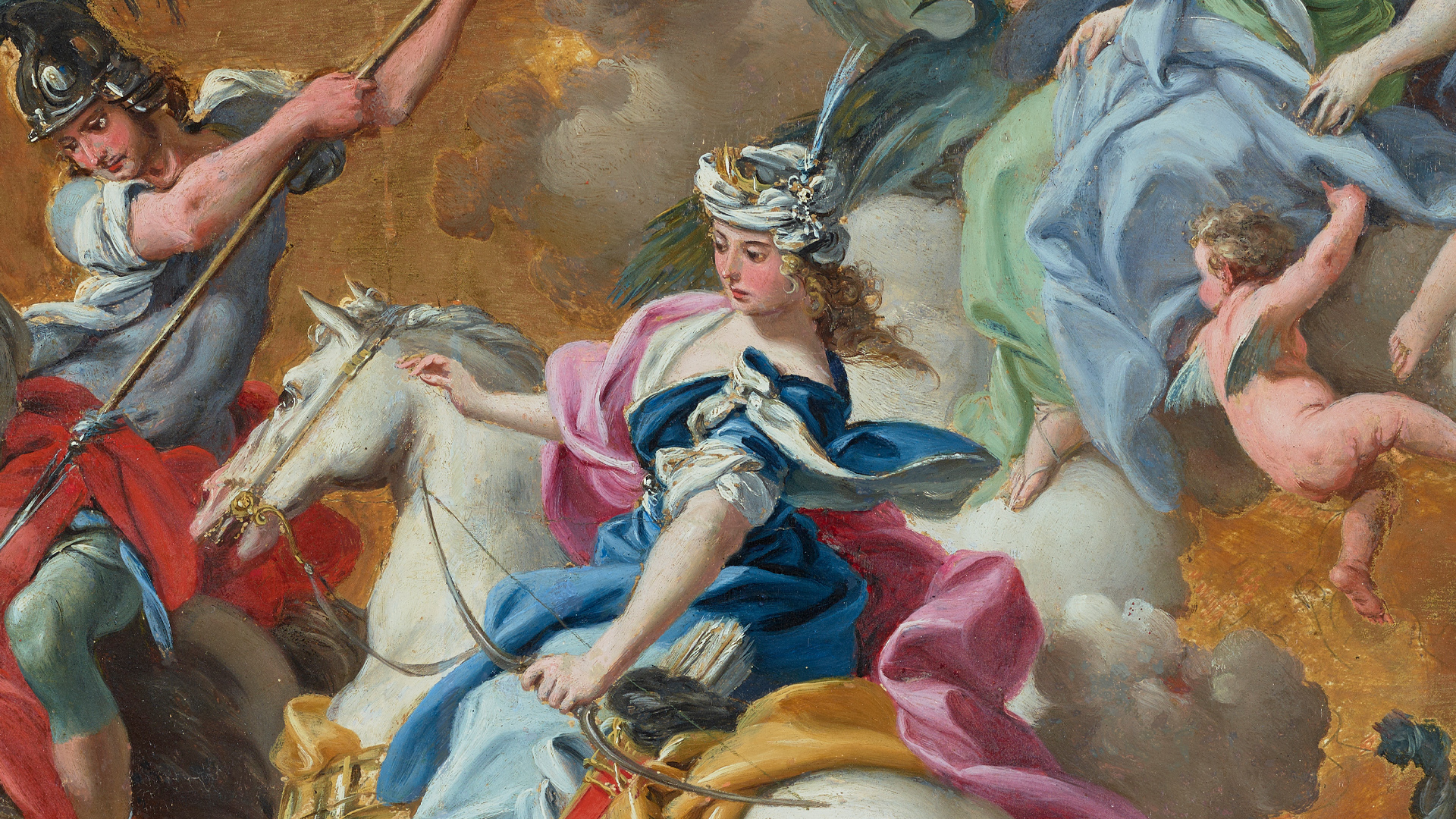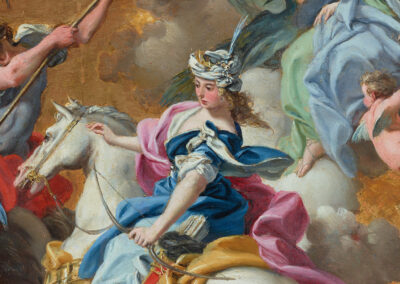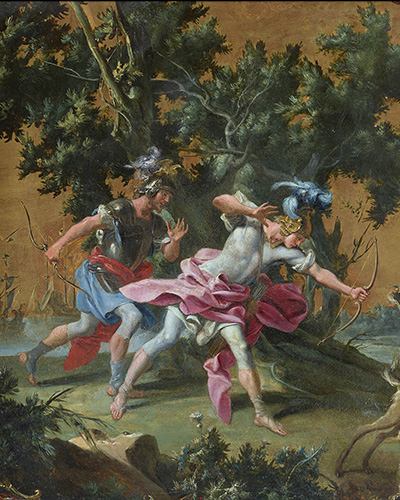In the collection of the Ducal House of Medinaceli Foundation, which is very rich in 17th-century Neapolitan painting, and in particular in the Casa de Pilatos, there are two compositions, hitherto unpublished, which document a particular moment in Italian painting in the 18th century in the midst of the Rococo period. They are two panels with gold backgrounds depicting two episodes taken from Virgil's Aeneid: "...", "..." and "...".Aeneas and Acates hunting a pair of deer." y "Aeneas and Dido hunt a stag under the gaze of Juno".
Traditionally attributed to Fedele Fischetti (based on the artist's specialisation in paintings on panel with gilt backgrounds to decorate chairs, chests of drawers, wardrobes and bedheads), a Neapolitan painter from the second half of the 19th century who was still inclined to follow the model of Girolamo Pompeo Batoni, Antonio Raffaello Mengs and Angelica Kauffman, These two refined compositions, however, are identical to two other paintings, both on panel with gilt backgrounds, which appeared in 1999 in the Patrick Matthiessen Gallery in London and were certainly painted by Filippo Falciatore, a painter documented in Naples between 1728 and 1768.
Initially trained by Paolo de Matteis, he then joined the workshop of the architect, sculptor and painter Domenico Antonio Vaccaro, with whom he worked in 1741 on the frescoes in the sacristy of the Church of Carmine Maggiore in Naples, in addition to various scenes from everyday life, the panels with a gilt background for the armchair of Queen Maria Amalia of Saxony, between 1737 and 1738, on the occasion of her marriage to Charles of Bourbon, VII of the Kingdom of Naples, III of Spain from 1759, which were erroneously identified by Vitzthum in 1967 with the panels belonging to the collection of the Museo Nazionale della Ceramica ".Duca de Martina"which depict, within a phytomorphic framework with refined rocaille solutions, various episodes from the stories of Perseus or Leda and the Swan (Vitzthum, 1967, pp. 18-23; for other paintings and other information about the painter, see N. Spinosa: 1987 p. 153 and 273; 2009 Vol I, pp. 320-331. 153 and 276; 2009 Vol I, pp. 320-331).
Paintings which, however - like the two panels in the House of Pilate or the two replicas in the Mathiessen Gallery or the numerous canvases and panels depicting episodes of popular or mundane life, rural or urban scenes, biblical, evangelical episodes or those of the Liberated Jerusalem (Institute of Art in Detroit, Staatsgalerie in Stuttgart, Bremen Museum, Carthusian Monastery and San Martino Museum in Naples, auction sales in London and New York, private collections in Italy and abroad) - were created as very much like paintings, Staatsgalerie of Stuttgart, Museum of Bremen, Charterhouse and Museum of San Martino in Naples, auction sales in London and New York, private collections in Italy and abroad) - were made in 1750 at the earliest and with solutions totally different from the compositions with "The Jerusalem of the Liberation".gender scenes"painted by Giusseppe Bonito before 1740 and by Gaspare Traversi before and after 1750. These canvases and panels, most often painted on a gold ground, are delightful compositions executed as if they were illustrating, with subtle and amusing irony, episodes from "...".chronicle"Falciatore's daily newspaper in the mid-seventeenth century, when Naples, under Charles of Bourbon, was once again the capital of an independent kingdom, the seat of a court of the highest dynastic prestige and an important stage for cultured travellers from all over Europe.
The whole set, like the two tables of the Casa Ducal de Medinaceli in Seville, executed with a studied layout against a maritime or country backdrop and like the scene of an open-air theatre or the interior of a noble Neapolitan house of fishermen and washerwomen, shepherds and peasants, refined ladies and elegant ".gentlemen" generally "in reduced dimensions"and always with pleasing forms and graceful attitudes, like the delicately coloured porcelain statuettes that in the same years were skilfully modelled in the Royal Factory of Capodimonte. But in the case of the images painted by Falciatore the pictorial effect is even more refined and precious thanks to the careful use of light tones and soft chromatic glazes, identical to the fabrics finely worked with coloured silk threads.
It is not improbable, given the hunting scenes they depict, that these two panels, like the identical ones in the Mathiessen Gallery in London, were originally used to decorate a carriage or a carriage used by the Neapolitan nobility to go hunting, carriages and carriages that were made almost "...".in series"and for which panels depicting such scenes were required to decorate them. This would explain why we now know of two pairs of panels by Filippo Falciatore, as in other famous compositions by him, with identical scenes taken from Virgil's poem.
Nicola Spinosa, April 2010




